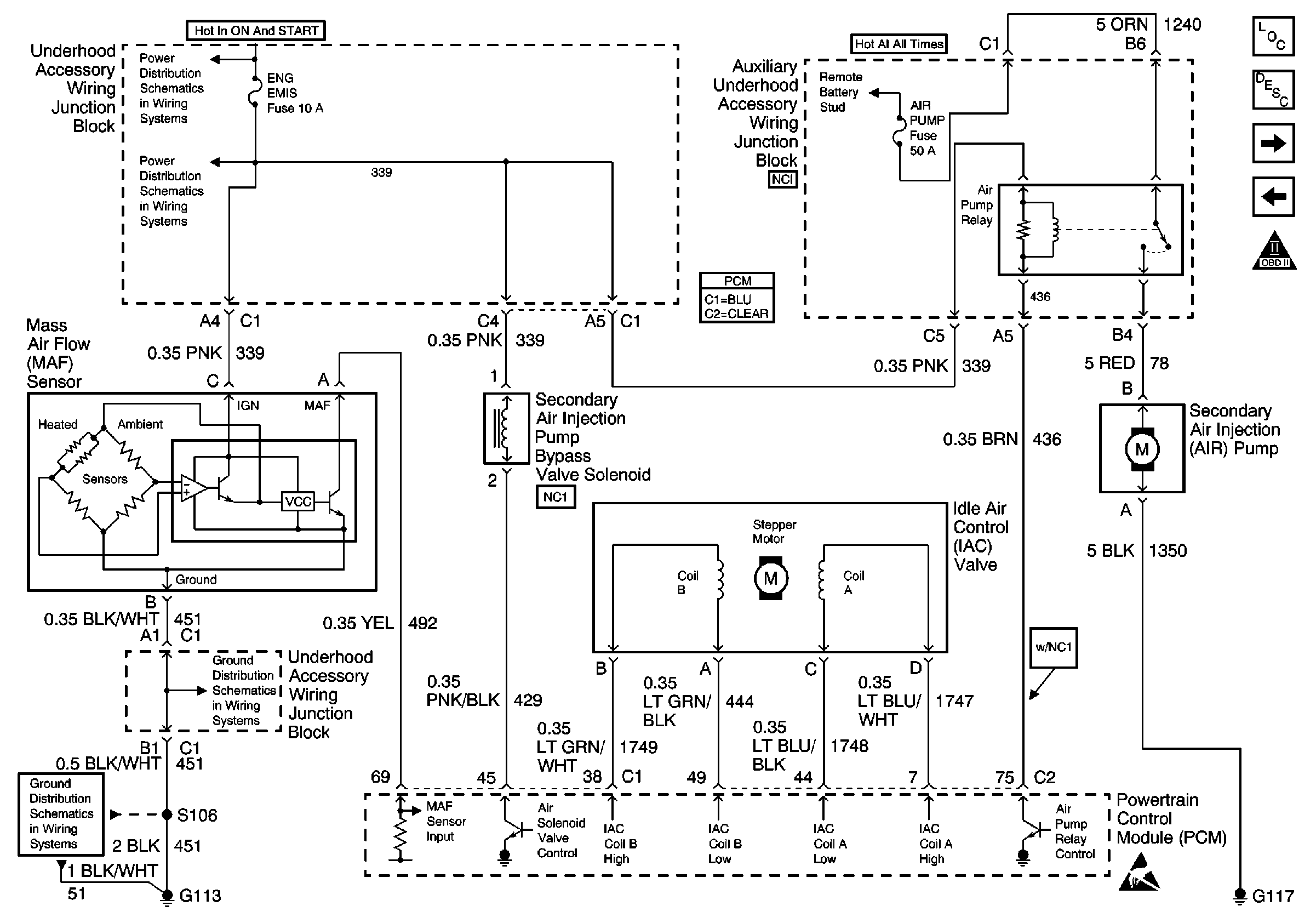Refer to Engine Controls Schematics
MAF, Secondary Air Injection Pump Bypass Solenoid, IAC and Secondary
AIR Pump

.
Circuit Description
The powertrain control module (PCM) controls the engine idle speed by adjusting the position of the idle air control (IAC) motor pintle. The IAC is a bi-directional motor driven by 2 coils. The PCM pulses current to the IAC coils in steps, or counts, to extend the IAC pintle into a passage in the throttle body and decrease air flow. The PCM reverses the current pulses to retract the pintle and increase the air flow. This method allows highly accurate control of the idle speed and a quick response to changes in the engine load.
Diagnostic Aids
Use the J 35616 connector test adapter kit for any test that requires probing the PCM harness connectors, electrical center fuse/relay cavities, component terminals or a component harness connector. Using this kit will prevent damage caused by improper probing of connector terminals.
If the problem is intermittent, refer to Intermittent Conditions for diagnosis.
Check for the following conditions:
| • | A poor connection at the PCM or the IAC motor. Inspect the harness connectors for backed out terminals, improper mating, broken locks, improperly formed or damaged terminals, and poor terminal to wire connections. |
| • | A damaged harness. Inspect the wiring harness for damage. |
| • | A restricted air intake system. Check for a collapsed air intake duct, a restricted air filter element, or any foreign objects blocking the air intake system. |
| • | The throttle body. Check for objects blocking the IAC passage or the throttle bore, any excessive deposits in the IAC passage and on the IAC pintle, and any excessive deposits in the throttle bore and on the throttle plate. |
| Check for a sticking throttle plate. Also inspect the IAC passage for any deposits or any objects which will not allow the IAC pintle to fully extend. |
| • | A vacuum leak. Check for a condition that causes a vacuum leak, such as any disconnected or damaged hoses, any leaks at the EGR valve or at the EGR pipe-to-intake manifold, any leaks at throttle body, a faulty or incorrectly installed PCV valve, a disconnected intake manifold brake booster hose, etc. |
Reviewing the Failure Records vehicle mileage since the diagnostic test last failed may help determine how often the condition that caused the DTC to be set occurs. This may assist in diagnosing the condition.
Test Description
The numbers below refer to the step numbers on the diagnostic table.
Step | Action | Values | Yes | No | ||||||||||||||
|---|---|---|---|---|---|---|---|---|---|---|---|---|---|---|---|---|---|---|
1 | Did you perform the On-Board Diagnostic (OBD) System Check? | -- | ||||||||||||||||
2 |
Does the engine speed remain within the specified value of the Desired Idle for each RPM command? | ±100 RPM | System OK | |||||||||||||||
3 |
Does each node light cycle red and green, never OFF? | -- | ||||||||||||||||
4 |
Was a problem found and corrected? | -- | ||||||||||||||||
5 | Was a low idle symptom or rich condition noticed? | -- | ||||||||||||||||
6 | Visually and physically inspect for the following conditions:
Was a problem found and corrected? | -- | ||||||||||||||||
7 | Visually and physically inspect for the following conditions:
Was a problem found and corrected? | -- | ||||||||||||||||
8 |
Was a problem found and corrected? | -- | ||||||||||||||||
9 | Replace the IAC valve. Refer to Idle Air Control Valve Replacement . Is the action complete? | -- | -- | |||||||||||||||
10 |
Was a problem found and corrected? | -- | ||||||||||||||||
|
Important: The replacement PCM must be programmed. Replace the PCM. Refer to Powertrain Control Module Replacement/Programming . Is the action complete? | -- | |||||||||||||||||
12 |
Does the engine speed remain within the specified value of the Desired Idle for each RPM command? | ±50 RPM | System OK |
